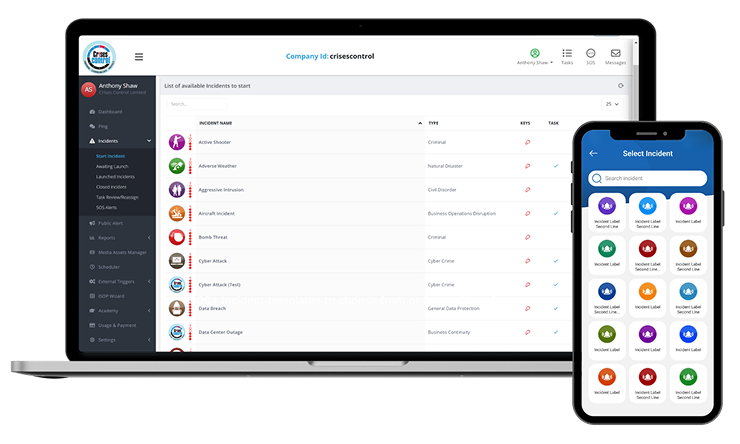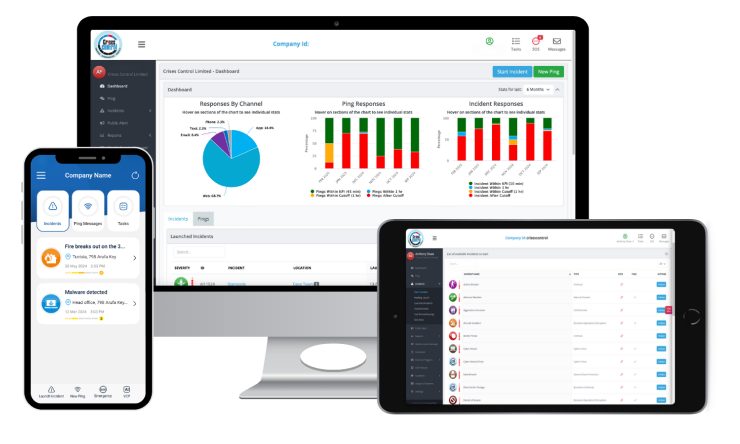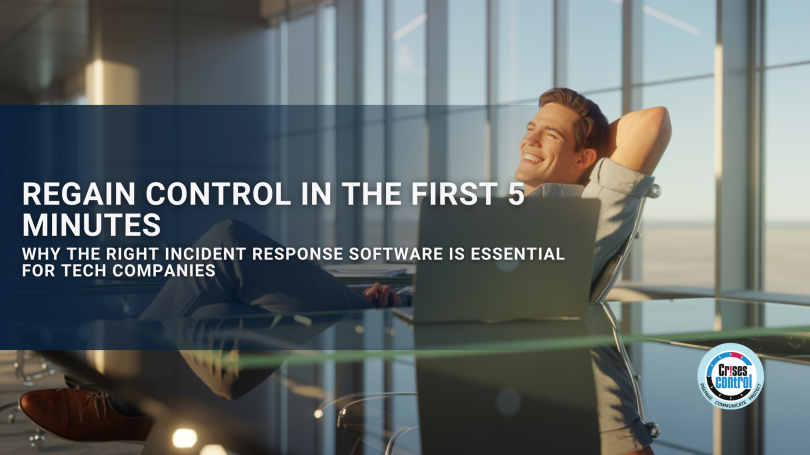Written by Anneri Fourie | Crises Control Executive
When a major incident strikes a technology company, the impact can be immediate and wide-reaching. A ransomware attack, a data breach, or a critical outage can disrupt services, damage reputation, and trigger regulatory scrutiny within minutes. The way an organisation responds during those first five minutes shapes the outcome more than any single tool or technical control.
In those opening moments, teams face a flood of alerts, fragmented communication, and pressure from both internal and external stakeholders. Decisions are made fast, often with limited information. When there is no clear incident response framework, confusion builds, tasks are duplicated or missed, and the situation spirals quickly.
This is a problem faced by many technology companies. The good news is that it can be fixed with the right incident response software. A well-structured system allows teams to act fast, stay connected, and communicate with precision. Crises Control helps organisations do exactly that by simplifying the way they detect, manage, and communicate during incidents.
Why Speed Shapes the Outcome of Every Incident
Technology companies rely on constant uptime to keep customers, partners, and internal systems connected. When something goes wrong, even short periods of downtime can cause serious damage. The longer the delay in responding, the more the costs increase.
Some of the most common impacts include:
- Direct revenue loss: Interruptions in service can lead to immediate financial losses, missed transactions, or compensation under service level agreements.
- Loss of trust: Customers expect reliability. Delays in communication can create uncertainty, frustration, and long-term reputational damage.
- Regulatory pressure: Many regions have strict reporting rules for cyber incidents. Delays in notifying regulators can lead to penalties or legal exposure.
- Longer recovery: If the first response is slow or unclear, the recovery process often becomes far more complex and time-consuming.
These risks can be significantly reduced with structured IT incident management and a reliable mass notification system. The right software makes sure that critical alerts reach the right people immediately, roles are clear, and escalation happens automatically.
Incident Response Software and the Critical First Five Minutes
The first five minutes after an incident begins set the tone for everything that follows. Many teams waste this time chasing the right contacts, sending manual messages, or trying to verify what is happening. With the right incident response software in place, the entire process becomes structured and predictable.
Here is a simple five-step framework that technology companies can follow:
Minute 0–1: Rapid Detection and Verification
Early detection saves valuable time. Monitoring tools can flag unusual activity, but without a direct response process, minutes can slip away before action begins. Crises Control integrates with monitoring systems to automatically trigger alerts, helping teams verify incidents quickly and remove delays in escalation.
Minute 1–2: Targeted Notifications and Escalation
Once an incident is confirmed, escalation must be immediate. Relying on email chains or chat platforms often leads to missed messages. Mass notification capabilities make sure that alerts reach response teams instantly. Crises Control sends messages across multiple channels including voice, SMS, push notification and email, increasing the chance that the right people see and act on the message.
Minute 2–3: Activating the Incident Response Playbook
Decisions made during the early minutes can be chaotic if there is no predefined plan. Playbooks outline who does what, which systems are affected, and how communication should flow. With Crises Control, these playbooks can be launched with one click, ensuring the right procedures are followed without hesitation.
Minute 3–4: Internal and External Communication
Technology companies often need to update more than just IT teams. Customers, partners, regulators and suppliers may all need to be informed. Clear and consistent communication maintains trust and prevents rumours from spreading. Crises Control supports controlled messaging to ensure updates are accurate and reach the right audiences.
Minute 4–5: Documentation and Compliance Logging
In many regions, incidents must be formally reported. Regulations like NIS2, GDPR, CIRCIA in the US and NESA in the UAE require evidence of incident handling. Crises Control records all communication, acknowledgements and task updates, creating an audit trail that supports compliance and post-incident reviews.
Why Manual Processes Fall Short
Many organisations still rely on manual steps to handle the first stage of incident response. These might include email lists, spreadsheets, messaging apps or static escalation trees. While these methods might work in low-pressure situations, they are unreliable when the stakes are high.
Manual response methods often lead to:
- Unclear ownership of critical tasks
- Delays in message delivery
- Conflicting or duplicated communication
- Missing records required for compliance reporting
Automation removes these weak points. With a structured incident response framework supported by the right software, information flows in real time, teams know their roles, and leadership has clear visibility over the situation.
How Crises Control Helps Technology Companies Respond Faster
Crises Control was designed to make rapid and coordinated incident response achievable for any organisation. For technology companies, it addresses both operational challenges and regulatory demands that often arise during an incident.
Real-Time Multi-Channel Alerting
Mass notification software allows teams to cut through the noise and reach people fast. Crises Control sends messages through multiple channels at once, making it far less likely that a critical alert is missed.
Automated Workflows and Incident Playbooks
Predefined workflows remove uncertainty during stressful moments. Teams can respond with confidence because the process is already mapped out. Crises Control enables one-click activation of incident plans for common events like ransomware attacks, data breaches or major service outages.
Unified Incident Management Dashboard
Coordinating multiple teams can be difficult during a crisis. Crises Control provides a clear dashboard that shows how incidents are progressing, who has acknowledged alerts, and which actions are still open. This improves coordination and reduces confusion.
Regulatory Reporting and Audit Trail
Technology companies often face strict reporting requirements. Crises Control keeps a detailed log of actions and communications, making it easier to meet compliance obligations and provide accurate records during reviews or investigations.
Integration with Monitoring Tools
Crises Control can be linked with existing monitoring systems to automatically trigger incident workflows. This removes delays and ensures no critical event is overlooked.

Interested in our Incident Management Software?
Launch and manage incidents in seconds with real-time dashboards, task management, multi-channel alerts, and mobile access for seamless response.
Building a Culture of Fast and Coordinated Response
Incident response is not just a technical process. It depends on people, communication and culture. Technology companies that respond effectively share some common habits:
- Clear escalation processes are practised through regular drills.
- Response frameworks are designed to match specific threats.
- Communication channels are streamlined to reduce noise.
- Leadership understands their role during the early minutes of an incident.
Crises Control helps organisations build this culture by providing an easy-to-use platform that supports planning, automation and collaboration. Instead of wasting energy chasing information, teams can focus on solving the problem.
Key Benefits of a Structured Incident Response Framework
A clear incident response framework creates more than operational efficiency. It brings measurable benefits that protect both the business and its customers.
- Faster recovery: Immediate notifications and predefined actions prevent small incidents from escalating.
- Stronger compliance: Automatic logs and reports make regulatory reporting less complex.
- Improved communication: Teams understand their roles and can act without hesitation.
- Increased customer confidence: Regular updates during incidents reduce uncertainty and protect trust.
- Better decision-making: Leadership has a clear view of events in real time.
These benefits have a direct impact on business continuity and reputation. When the first five minutes are handled well, the rest of the incident becomes easier to control.
Taking Control of the First Five Minutes
Technology companies face constant risk from cyberattacks, data breaches, system outages and other operational disruptions. These incidents can’t always be prevented, but their impact can be controlled. A fast and structured response during the first five minutes can make the difference between a manageable event and a damaging crisis.
IT incident management combined with mass notification software gives organisations the structure and speed needed to respond effectively. Crises Control brings these capabilities together in one platform, helping teams act quickly and keep operations running.
See How Crises Control Can Strengthen Your Response Strategy
A slow or disorganised response can cost a technology company far more than just downtime. A well-built incident response framework supported by the right software protects revenue, reputation and compliance standing.
Crises Control gives organisations the tools they need to act with precision, speed and clarity during the moments that matter most.
If you want to see how this works in practice, book your free demo now!
Request a FREE Demo

